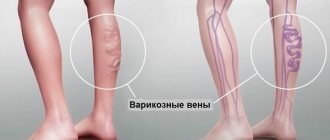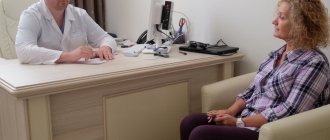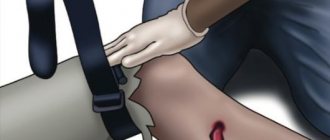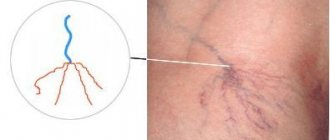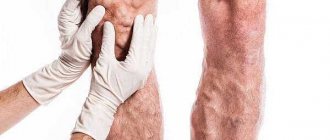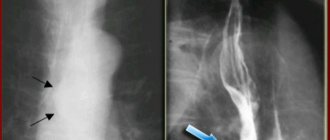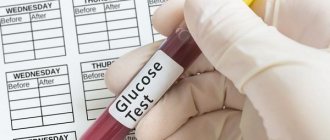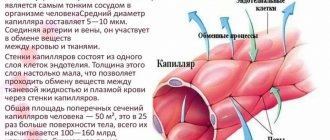- Phlebology Center
- /
- About the clinic
- /
- Helpful information
- /
- Male varicose veins
It is difficult for a modern man to find time to consult with a phlebologist, especially since varicose veins do not cause much concern at first. But it’s not for nothing that varicose veins are called an insidious disease that can lead to serious complications - thrombosis, trophic ulcers.
First of all, men with a hereditary predisposition to varicose veins should be attentive to their leg health. The cause of the development of the disease can also be:
- passion for strength training,
- intense physical activity,
- long and frequent driving trips.
Overweight men are also at risk. The main symptoms of the disease are pain and a feeling of heaviness in the legs, protruding veins, as well as swelling, which most often appear in the evening.
At the Phlebology Center, a complete diagnosis of the venous system is carried out immediately during the consultation. At the initial appointment, the phlebologist works together with the ultrasound specialist. This integrated approach allows you to quickly and accurately select a treatment regimen and is very convenient for the patient.
Do varicose veins occur in men?
Varicose veins are an insidious disease, all doctors and all information sources say this. The insidious thing is that there is not a single category of patients that it cannot reach. As public health statistics show, the age and gender of a person does not matter; the problem has begun to occur in everyone. Therefore, it is worth looking at the disease from a different angle - in which categories of patients can it manifest itself frequently, and in whom rarely?
Indeed, women encounter on average 5 times more often vascular pathologies than men. Firstly, because there are more factors for their occurrence in women. Secondly, because men are less careful about their own health and the percentage of them diagnosing the disease in the early stages is negligible. Therefore, to the question of why varicose veins on the legs in men are dangerous and whether they are dangerous in principle, we will answer that varicose veins certainly pose a threat to general health and, in this case, to the consequences it can provoke. Read more about what causes the disease, how to identify it, how and how to treat varicose veins on the legs in men.
EVLT: Treatment of varicose veins with laser
Intravascular laser coagulation (IVLC) is a complete alternative to traditional operations. This method allows you to get quick and effective results.
- Low trauma and high cosmetic effect. The light guide is inserted through a mini-puncture. No stitches required.
- "Office Surgery" EVLT takes place under local anesthesia and lasts from half an hour to two. After the procedure, on the same day, the patient leaves the clinic and can return to their normal lifestyle.
- Does not require special training. To conduct EVLT, a standard package of tests is sufficient, which can be taken at your place of residence or in our clinic.
Varicose veins on the legs in men: causes
To resist pathology, you should have information about it. The causes and signs of varicose veins on the legs of men are of great importance in this fight.
!
First of all, it is worth noting the hereditary factor.
It is possible to inherit varicose veins, as well as the characteristics of the connective tissue that make up the vascular walls. The main provoking factors for the development of pathology in men also include:
- bad habits - smoking and alcohol addiction;
- excessive passion for strength training;
- passive lifestyle;
- long-term driving;
- obesity;
- lack of diet and daily routine;
- chronic diseases of the kidneys, liver, etc.
All of us know that experiences weaken the body's protective functions. Can we say that varicose veins in men also arise from nerves? Such a direction of medicine as psychosomatics claims that in 75% of cases of the development of cardiovascular diseases, nerves play an important role. Therefore, an unstable emotional background may be one of the factors provoking the development of varicose veins.
Expert opinion
The etiology of vascular diseases is not fully understood. Therefore, the true list of causes and factors influencing the development of the disease can be large. Varicose veins in the legs are considered to be a polyvalent disease. In this regard, it is important to know what symptoms it has. This will allow you to see a doctor in time and receive treatment.
Vascular surgeon, phlebologist
Osipova Ekaterina Yakovlevna
Let us recall that the negative consequences of the development of varicose veins on the legs in men are formed mainly due to a late visit to a specialist, including due to ignorance of the clinical picture of the disease.
Signs of varicose veins on the legs
Preserve men's health. Varicocele: what is it and how to get rid of it?
Despite the fact that this disease is quite common, the average person knows little about it. What causes varicocele and what does it mean for a man? How are varicoceles diagnosed and treated?
These and other questions are answered by Anatoly Vladimirovich Vavilin, a urologist at Clinic Expert Perm.
— Anatoly Vladimirovich, what kind of disease is this – varicocele? Does it have anything in common with varicose veins on the legs? Sounds similar...
— Varicocele is a varicose vein of the pampiniform plexus of the spermatic cord. With this disease, the functioning of the valve mechanism of the veins is disrupted, as a result, the outflow of blood through them worsens, and the veins dilate.
This pathology is considered quite common. For example, during conscription for military service, varicocele is detected in 1-7% of young people. The highest incidence of varicocele (15-19.3%) occurs at 14-15 years of age. In children under 10 years of age, this disease occurs in 0.7-5.7% of cases.
Varicocele does not pose a threat to life, but often becomes a cause of male infertility. What is common with varicose veins of the lower extremities is that in both cases we are talking about varicose veins.
— Are the causes of the pathology known? Why does a varicocele appear?
— The disease can be congenital or acquired. Most often, varicocele is recorded in the left testicle, where the spermatic vein connects to the renal vein - this is usually the result of a congenital pathology. However, varicocele is not a genetic disease.
Less commonly, the disease affects both testicles, and even less often, only the right one. In such cases, we can talk about an acquired form of the disease, which often signals an oncological pathology. An acquired varicocele on the right can be provoked by a tumor of the right kidney, both malignant and benign.
— How does varicocele manifest?
— At the initial stage of development of the disease, most often nothing happens. At the second stage, discomfort in the groin and pain in the testicle may occur. In the third stage, the manifestations are the same as in the second.
I would like to note that pain in the testicles is not always a varicocele: the same sensations arise, for example, with chronic prostatitis, with inflammation of the epididymis.
— How is varicocele determined in men? What is the diagnosis?
— There are three stages of the disease. In the first, the dilation of the veins of the spermatic cord is not visible to the naked eye, but they can be felt. On the second, dilated veins can already be seen, and they can also be felt. On the third, all the problems are already visible so clearly that it is impossible to make a mistake with the diagnosis.
Most often, congenital varicocele is discovered by chance - during the examination of young people during a medical examination during conscription. By the way, the examination is carried out with the patient standing, because when a person lies down, these dilated veins collapse and are not visible. Also, to diagnose varicocele, an ultrasound of the scrotum is performed: you can see the size of the varicose veins and determine the stage of the disease.
Often the diagnosis of “varicocele” is made when a married couple comes to the doctor with the problem of infertility. The man submits his sperm for analysis, the doctor sees a certain problem in the spermogram, and upon examination finds dilated veins of the spermatic cord. If such a married couple wants to have children, the man first of all needs to get rid of varicocele, since this pathology affects spermatogenesis (the development of male germ cells). Why is this happening? The blood does not drain well from the testicle, it stagnates, and because of this the temperature in it rises. Not by much, about half a degree, but this is enough to cause problems with spermatogenesis.
— Can varicocele go away on its own, without treatment?
- Definitely not.
— Tell us about existing methods of treating the disease. Is it possible to cure varicocele without surgery? And is there a chance to get rid of this pathology forever?
— Not so long ago, about 15 years ago, all patients with varicocele were sent for surgery. Now, if the first stage of the disease is detected and nothing bothers the person, you can do without surgical intervention. You just need to be observed: if the varicocele does not progress, a person can live quite a long time with this first stage without any problems.
If the question of treatment still arises, then it is only surgical. If the operation is successfully performed, the person can forget about the problem.
— How are operations performed for varicocele?
— There are several options. The simplest is the Ivanissevich operation. In the left iliac region, just above the inguinal fold, the doctor makes an incision of about 5 centimeters, identifies the testicular vein and crosses it.
The Marmara operation is more complex - it belongs to the category of microsurgical. Through a small incision, no more than a centimeter in size, the spermatic cord is isolated and all small veins are ligated, after which the blood flows out through other veins.
Now another type of operation has appeared; it is a minimally invasive x-ray surgical endovascular procedure. To carry it out, you need specially trained doctors and expensive equipment, so such operations are not common and are carried out mainly in large centers.
— What are the possible complications after surgery for varicocele?
— As a rule, such operations are not burdened with any serious complications. However, it happens that the operation is performed, but the problem is not eliminated, the veins remain dilated.
One of the most common complications is recurrence of varicocele. Each type of surgical intervention has a certain probability of the pathological process returning. In the case of traditional surgery, this probability is 40%, with endovascular treatment – 15%, laparoscopy – up to 10% and with microsurgical surgery – no more than 2%.
All other complications are extremely rare and are mainly associated with violation of the surgical technique. For example, sometimes after surgery, water in the membranes of the testicle (hydrocele) may occur. This happens, in particular, when crossing lymphatic vessels.
— What are the causes of varicocele recurrence?
— The reason for the relapse is the presence of so-called backup veins, through which blood again fills the veins of the pampiniform plexus. The relapse rate during the Ivanissevich operation is higher, since during it only the common testicular vein is ligated, without taking into account the backup veins. But with a microsurgical operation (Marmara), there are fewer relapses, since all branches of the testicular vein are ligated.
— What will happen if this disease is not treated? How does varicocele threaten a man?
— As I said earlier, the disease does not pose a threat to life. However, it affects a man’s spermatogenesis, that is, it can become one of the causes of male infertility.
Read
Symptoms and signs of varicose veins in men
As a rule, men ignore symptoms such as heaviness in the legs, pain, cramps, spider veins, dryness and redness of the skin. And only when persistent swelling, large varicose veins and or even non-healing ulcerative skin lesions on the legs appear, which clearly indicate varicose veins on the right, but more often, the left leg, then they are ready to see a doctor. In this case, it is extremely difficult or practically impossible to carry out conservative treatment of varicose veins in men on the legs, namely treatment without surgery.
!
To prevent varicose veins on the legs in men from developing into advanced stages, and from requiring surgery to remove varicose veins of the lower extremities, it is important to listen to the “signals” that the body gives!
What to do and how to act correctly if symptoms of the disease are detected? As soon as a person notices one, several or all of the symptoms, he should seek advice from a specialist as soon as possible. The doctor will collect an anamnesis of the disease, perform an examination, and prescribe the necessary diagnostics to confirm the preliminary diagnosis. After which therapy will be prescribed corresponding to the stage of varicose veins.
Treatment of varicose veins
The main cause of varicose veins is heredity!
The main cause of varicose veins is a hereditary factor
It should be noted that man is the only creature on Earth that has the ability to move in an upright position, therefore, the load on the legs in this situation is maximum. It is important to remember that a modern sedentary lifestyle – “office work” – also leads to venous stagnation in the lower extremities. Pregnancy and childbirth (especially repeated ones) often become a trigger in the development of varicose veins of the lower extremities. It must be taken into account that a moderate amount of physical activity throughout the day is necessary for the normal functioning of all organs and systems of the body, and this is especially important in relation to the cardiovascular system, which includes the veins. Dynamic activity forces the muscle pump of the calf muscles to work, which in turn leads to increased outflow of stagnant venous blood from the lower extremities.
How to treat varicose veins on men's legs using traditional medicine?
How to treat varicose veins? In accordance with the stage at which the disease was diagnosed, conservative therapy methods and or surgery will be applied. Surgical treatment is used in cases where it is no longer possible to avoid it. There are various treatments for varicose veins. The attending physician determines which method is most suitable for the patient. How to treat varicose veins on the legs in men conservatively?
Methods of conservative therapy are varied. They are divided into medicinal and non-medicinal. The first include medications and external agents that help strengthen the vascular system, reduce fragility and increase the strength of the walls of blood vessels, as well as drugs that thin the blood and remove toxins. For these purposes, patients are prescribed phlebotonics, anticoagulants and antioxidants. The most effective are those containing heparin and troxerutin. If varicose veins in men are detected at an early stage, then to maintain the health of the lower extremities and prevent problems with blood vessels, you can use NORMAVEN® cream to reduce the syndrome of heaviness and fatigue in the legs.
Non-drug treatment methods include doctor’s recommendations for changing eating behavior and maintaining a healthy lifestyle, lifestyle modification.
!
Compression garments have a positive effect.
This type of treatment is used quite often in men. Orthopedic salons quite widely present compression products, among which there is a variety of compression hosiery: knee socks, stockings for the treatment of varicose veins of the legs. The color palette and quality of knitwear sometimes makes it difficult to distinguish them from ordinary socks. In any case, the issue of health is a priority over possible inconvenience and embarrassment. Exactly which socks or stockings and what compression class are used to treat varicose veins in men will depend on the stage of varicose veins. The class of compression hosiery is always selected by a doctor.
Varicose veins causes. Modern theories of the appearance of varicose veins.
There are several modern theories of the development of varicose veins. The main one is hereditary predisposition, the presence of the disease in close relatives. Data from authoritative European researchers indicate a direct correlation between heredity and the incidence of varicose veins. Also, modern medical science identifies the following necessary conditions for the appearance of varicose veins:
- Mechanical factors are heavy physical activity, pregnancy, work associated with prolonged standing.
- Hormonal and endocrine disorders during puberty, during pregnancy, after childbirth.
- Sedentary lifestyle, overweight, smoking, alcohol abuse. Any of these reasons can serve as an impetus for the appearance of the first signs of varicose veins.
Main causes of varicose veins
Thus, from the point of view of European researchers, heredity alone is still not enough and certain conditions are necessary for the appearance of varicose veins. Quite banal reasons can provoke varicose veins, especially if there is a hereditary factor. The risk group includes those people who lead a sedentary lifestyle or, on the contrary, spend all day on their feet. An additional reason can be a change in hormonal levels, which most often occurs in women as a result of taking contraceptives or during pregnancy.
How to treat varicose veins on the legs in men at home or treatment with folk remedies
In the first stages, varicose veins in men can be treated at home, including using folk recipes, but only after consulting a doctor. At home you can:
- perform therapeutic exercises (“bicycle”, “birch tree”);
- do massage and self-massage, incl. using orthopedic mats;
- take water procedures (baths with decoctions, contrast showers);
- make lotions and compresses (from sea salt, honey, apple cider vinegar, wormwood);
- rub your feet with rubs based on horse chestnut, garlic, Kalanchoe, etc.
There are a large number of folk recipes and medical recommendations for treating vascular diseases at home. But do not forget that this is just an addition to the main therapeutic regimen.
Prevention of varicose veins
Treatment methods for varicose veins of the lower extremities without surgery
Only an integrated approach to the treatment of varicose veins without surgery will help get rid of the pathology. Treatment of veins without surgery should include complete lifestyle correction:
- Physical exercise,
- Diet;
- Compression effect on the affected areas;
- Drug therapy;
- Folk remedies;
- Minimally invasive methods.
Doctors at the Yusupov Hospital advise starting treatment with lifestyle adjustments, trying to move more, introducing walking, doing fitness or doing exercises at home. Running and swimming with swollen veins are considered very effective. It is also necessary to reconsider your usual diet. Fatty and fried foods, hot seasonings, carbonated drinks, alcohol, baked goods, and sweets should be removed from it. Fill your diet with vegetables, fruits, fruit drinks, cereals, and drink clean water. It is recommended to eat seafood: seaweed, shrimp, squid, mussels. They are rich in copper, and it has a positive effect on the condition of blood vessels, strengthens them and restores their elasticity. It is necessary to build a diet so that dinner takes place no later than 4 hours before going to bed. You should eat food in small portions. A nutritionist at the Yusupov Hospital will calculate the required diet, taking into account all the individual characteristics of the patient.
Partially, how to remove veins on the legs without surgery is solved by compression garments. It puts pressure on the legs and thereby restores normal blood flow in the vessels. Varieties of compression garments are used depending on the location of the process; these can be tights, stockings, or knee socks. Orthopedic clothing is also used to treat varicose veins without surgery. It is presented in different classes and models, which differ in pressure force. A specialist at the Yusupov Hospital will determine what kind of pressure is needed after determining the degree of the disease. Such products are also recommended to be used to prevent the development of the disease. The need to wear compression stockings is also determined by a specialist. As a rule, they put it on in the morning, without getting out of bed, and take it off only before going to bed.
